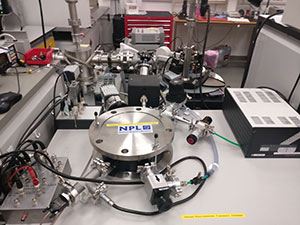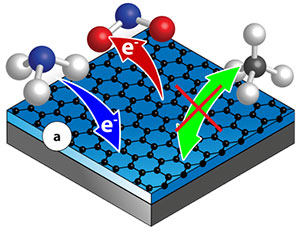We focus on physics, engineering and metrology of materials and devices for quantum computation and sensing, such as two-dimensional materials and their van der Waals heterostructures, Moiré materials, topological insulators, Weyl semimetals, superconductors, metamaterials, semiconductor quantum dots, spin-based systems (such as colour centres, topologically protected spin structures) and others.
We deploy quantum metrology, scanning probe microscopy, spectroscopy, magneto-transport and magneto-optical methods to support quantum technologies resesarch in the UK. Materials metrology is vital in order to characterise and image electrical, optoelectronic and magnetic properties in different environments:

Low-temperature 4-probe scanning tunnelling microscope
We develop:
Reliable methods to determine the quality and physical properties of quantum materials are vital to their widespread inclusion in practical devices with novel functions. We use a wide suite of tools to characterise these materials in terms of their properties.
Structural properties – With our Atomic Force Microscopy (AFM), Scanning Tunnelling Microscopy (STM) and confocal Raman spectroscopy facilities, we can measure a variety of the structural properties of quantum materials, such as material thickness, coverage, defect state and strain.

Atomically resolved surfaces by STM and qPlus AFM
Electric and electronic properties – We can probe properties such as surface potential, carrier density distribution, band structure, sheet resistance and electrical transport with techniques including Kelvin Probe Force Microscopy (KPFM), van der Pauw and Hall measurements, FET measurements (including Dirac point and conductivity vs. gate voltage), microwave resonator techniques and our conventional four probe and state of the art ultra high vacuum (UHV) four-probe STM system.
Optical properties – Our suite of optical techniques, including Raman and photoluminescence spectroscopy, as well as Scanning Near Field Optical Microscopy (SNOM), can measure the optical properties of quantum materials from the visible to the infrared.
Diffraction-beating imaging using SNOM
Thermal properties – We measure the nanoscale thermal conductivities of a range of samples using Scanning Thermal Microscopy (SThM), in both ambient conditions and vacuum, and Nanoscale Thermal Analysis (nanoTA).
Chemical properties – With Raman and photoluminescence, we can distinguish and characterise many different quantum materials, using a mixture of spectroscopic analysis and spatial mapping of sample composition. Additionally, we can identify and pinpoint various chemical species, such as functionalised groups on graphene, with nanoscale spatial resolution using AFM-infrared spectroscopy (AFM-IR).
Find out more about NPL’s Nanoprobe facilities & consultancy
.
The quantum Hall effect is used to define the metrological standard for electrical resistance in terms of the ratio of fundamental constants of nature, Planck’s constant (h) and the square of the elementary charge (e). Graphene supports the quantum Hall effect in much more relaxed conditions, higher temperature and lower magnetic field, than conventional semiconductors. Our push-button quantum Hall resistance standards with graphene at their heart will be used in industry to create more accurate electronic components.


The large surface area of graphene means it is very sensitive to molecules that contact its surface, which makes it ideal for use in sensors. With our in-house-designed environmental chamber, we perform a variety of electrical transport measurements on sensors in a controlled atmosphere, with variable gas content , temperature and humidity . We can also run AFM based experiments in a controlled environment, to investigate how atmospheric changes affect the structural and electronic properties of quantum materials. We investigate and develop graphene-based sensors, including gas sensors to detect harmful pollutants such as NO2, CO and CO2.
We also develop novel biosensors which could detect hepatitis biomarkers, allergens and other disease-carrying pathogens.
With our research and capabilities, we are building confidence in new materials and unlocking their use for new applications
Find out moreWith our standards, we create a foundation for international acceptance and best practices in measurements across multiple disciplines
Find out moreOur research and measurement solutions support innovation and product development. We work with companies to deliver business advantage and commercial success.
Contact our Customer Services team on +44 20 8943 7070